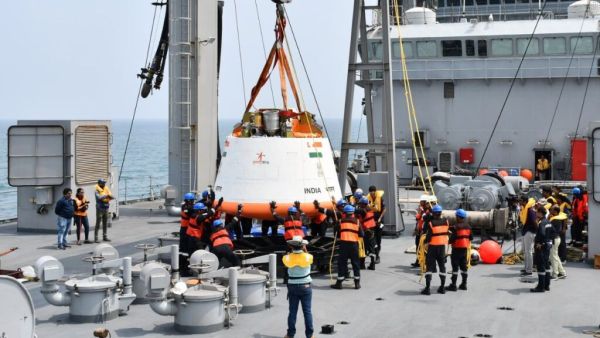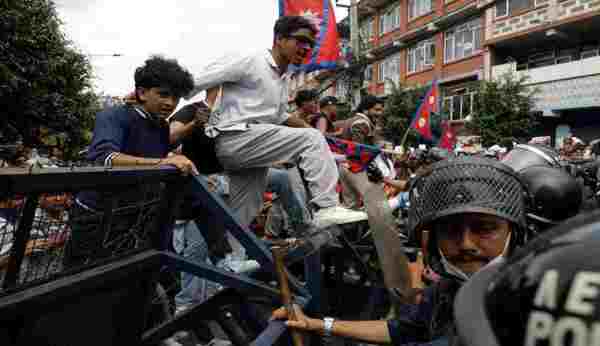
August 24, 2025, marked a historic moment for India’s space ambitions as the Indian Space Research Organisation (ISRO) successfully conducted its first Integrated Air Drop Test (IADT-01) for the Gaganyaan program at the Satish Dhawan Space Centre in Sriharikota. This milestone achievement brings India one step closer to joining the elite club of nations capable of sending humans to space and bringing them back safely.
The Integrated Air Drop Test
ISRO’s successful Integrated Air Drop Test (IADT-01) marks a pivotal step in validating the parachute-based deceleration system essential for astronaut recovery and overall mission safety. This achievement strengthens India’s path toward independent human spaceflight and will be very significant for the Gaganyaan mission. This achievement is crucial for astronaut safety, ensuring smooth ocean landing after re-entry, while reducing risks associated with shock, impact, and instability. It also reflects a collaborative approach with contributions from the Indian Air Force, Navy, DRDO, and Coast Guard, showcasing India’s integrated effort in human spaceflight.
“The test involved dropping a simulated crew module weighing about 5 tonnes from an Indian Air Force helicopter at an altitude of 3.1 to 4 km over the Bay of Bengal. The module descended using a sequence of drogue, pilot, and main parachutes, culminating in a gentle splashdown within minutes. The end-to-end deployment was demonstrated successfully, confirming the system’s capability to stabilise and decelerate the crew module during re-entry and landing,” explained Srimathy Kesan, founder and CEO of Space Kidz India.
The success of the air drop test brings multiple benefits. It greatly boosts operational confidence in the Gaganyaan mission, validates indigenous parachute technologies, and positions India to become the fourth nation with independent crewed spaceflight capability. This milestone not only enhances India’s global standing but also opens doors for future collaborations and technological innovations.
“Before any human can venture into the cosmos, every single component of the mission must be tested to perfection. The parachute system, which is literally a matter of life and death for returning astronauts, underwent its most crucial test on August 24, 2025. The test was designed to validate the critical parachute-based deceleration system that will be responsible for bringing the Crew Module safely back to Earth during the actual Gaganyaan mission. Think of it as the ultimate safety net that ensures astronauts don’t crash-land but gently touch down on the sea surface. The importance of this system cannot be overstated; it’s what stands between a successful mission and a potential disaster,” remarked space analyst Girish Linganna.
The complexity of the test itself demonstrates ISRO’s meticulous approach to human safety. A simulated Crew Module weighing approximately 4.8 tonnes was suspended from an Indian Air Force Chinook heavy-lift helicopter and released from an altitude of 3 kilometres above the ground. This wasn’t just about dropping something from a helicopter; it was about recreating the exact conditions that a returning spacecraft would face during one of the most critical phases of its journey.
The parachute system
The parachute system employed in the test was identical to what will be used in actual Gaganyaan missions. It comprised four different types of parachutes, each serving a specific purpose in the carefully choreographed descent sequence. The system included two Apex Cover Separation (ACS) parachutes with 2.5-meter diameters, two Drogue parachutes measuring 5.8 meters across, three Pilot parachutes of 3.4-meter diameter, and three massive main parachutes with 25-meter diameters, a total of ten parachutes working in perfect harmony.
Each type of parachute has a distinct role in ensuring safe descent. The Apex Cover Separation parachutes are the first to deploy and are responsible for pulling away the protective cover from the top of the Crew Module, clearing the path for subsequent parachutes. The Drogue parachutes act as the primary braking system, dramatically slowing down the high-speed descent from space. The Pilot parachutes serve as extractors; they pull out and deploy the much larger main parachutes. Finally, the Main parachutes, being the largest in the system, provide the final and most crucial deceleration, bringing the spacecraft to a gentle landing speed.
Deployment
The deployment sequence began with the firing of the ACS Mortar – a small explosive device that acts like a controlled cannon to forcefully eject and deploy the Apex Cover Separation parachutes, initiating the separation of the apex cover from the descending module. This was followed by the deployment of Drogue parachutes, which provided the first stage of deceleration. After completing their job, these parachutes were released, making way for the Pilot parachutes, which then extracted and deployed the three large main parachutes with diameters of 25 meters each.
The precision required for this sequence is extraordinary. Each parachute must deploy at exactly the right moment, at the right speed, and in the right sequence. Any failure in timing could result in catastrophic consequences. The successful test demonstrated that the system could reduce the terminal velocity of the Crew Module to about 8 meters per second – slow enough for a safe splashdown in the sea.
What makes this achievement even more remarkable is that the test simulated a launch pad abort scenario – one of the most challenging situations that could occur during a space mission. This means that even if something goes wrong during launch, astronauts would still have a reliable escape route back to safety.
Collaboration
The test wasn’t conducted in isolation. Extensive computer modeling was carried out to understand the complex dynamics of the helicopter-suspended module system. Multiple trial runs were conducted with dummy hardware to validate every aspect of the mission profile and standard operating procedures. The Test Authorisation Board cleared the test only after ensuring that every possible scenario had been considered and prepared for.
The collaborative nature of this achievement highlights the strength of India’s defense and space ecosystem. Apart from ISRO’s various centers, the Defense Research and Development Organisation (DRDO), Indian Air Force, Indian Navy, and Indian Coast Guard all contributed their expertise to make this test successful. This inter-agency cooperation demonstrates India’s unified approach to achieving its space goals.
“The onboard avionics systems performed flawlessly during the test, continuously measuring various parameters and transmitting data to ground stations while also storing information onboard using a Solid State Data Recorder. After splashdown, the simulated Crew Module was successfully recovered by INS Anvesha and brought back to Chennai port, completing the entire test cycle from deployment to recovery,” added Linganna.
This successful test represents more than just a technical achievement; it’s a testament to India’s growing capabilities in cutting-edge aerospace technology. The Gaganyaan program, when completed, will make India only the fourth country in the world to independently send humans to space, joining the ranks of Russia, the United States, and China.
More tests
However, experts point out that this is just the beginning. ISRO has plans for similar tests under different deployment conditions in the coming days. Each test will add another layer of confidence to the system’s reliability and bring the actual human spaceflight mission closer to reality.
Behind this achievement lie significant innovations, including the development of indigenous parachute and deceleration systems, advanced module design with real-time monitoring and recovery simulations, and strong participation from Indian industry—driving both innovation and employment within the country.
However, challenges remain. “Designing safe launch and recovery systems that meet global standards is technically complex. Building reliable life-support systems and training astronauts with limited simulation facilities in India requires innovation and international collaboration. Developing regenerative systems for water, air, and waste management adds further engineering hurdles, shared by human spaceflight programs worldwide,” remarked Kesan.
-
leader Diwakar Dangal: Nepal’s Gen Z Leader Speaks Out, “They’re Trying to Break Us”

-
Talwiinder’s Halloween tour promises mystery, music, and self-expression: Check details

-
Mental health and relationship strength

-
Barneys heir served with explosive tax-fraud lawsuit at NYC book event

-
These 2 people of these 2 nominees are very strong, always support each other
